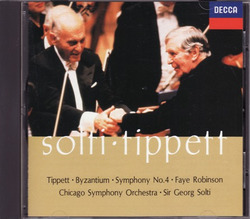Tippett Symphony No 4. Byzantium
View record and artist detailsRecord and Artist Details
Composer or Director: Michael Tippett
Label: Decca
Magazine Review Date: 4/1993
Media Format: CD or Download
Media Runtime: 58
Mastering:
DDD
Catalogue Number: 433 668-2DH

Tracks:
| Composition | Artist Credit |
|---|---|
| Byzantium |
Michael Tippett, Composer
Chicago Symphony Orchestra Faye Robinson, Soprano Georg Solti, Conductor Michael Tippett, Composer |
| Symphony No. 4 |
Michael Tippett, Composer
Chicago Symphony Orchestra Georg Solti, Conductor Michael Tippett, Composer |
Author: Michael Oliver
For its length (27 minutes) Byzantium is Tippett's most image-rich score to date. Of course the uncheckable teeming of images in an artist's consciousness is the very subject of Yeats's poem. You can sense Tippett's excitement at finding a way of rendering the seeming contradictions of ''dying/dance, flame/trance'' in verse 4, and his ravishing, almost visible ''a starlit or a moonlit dome'', the burnished dazzle of his ''miracle, bird or golden handiwork'', tells us why he was for so long attracted to the poem. However, to honour the half-century-long tradition of expressing doubts about each of Tippett's new works as they have appeared, isn't the incessant (and hair-raisingly difficult) intensity of the soprano line rather exhaustingly unrelieved? And despite an obvious recall of earlier material at the end, does this succession of gorgeous and strange events really hang together as an entity?
That, you recall, was one of the perplexities expressed at the time about the Fourth Symphony: did its violent juxtapositions of material really have an iron, inevitable logic to them? I am now ashamed of having shared that doubt, and listening again to Solti's reading confirms once more that it is a masterpiece, one of Tippett's grandest images of wholeness embracing diversity, in terms of vividly imagined sound perhaps the most magical of his purely orchestral works.
All of which is not a prelude to a conclusion that we must take Byzantium on trust. But we might notice that although the intensity of the soprano's line is pretty well constant (so is the tension of Yeats's great, mysterious poem), its style is not: Tippett's angles give way to broad curves, hypnotic mutterings, rapt melisma. Unity, I am convinced, is there, but in an apt setting of this text you wouldn't expect it to be a conventional formal unity. A sense that each verse adds to the structure, that the end is emotionally satisfying, yes, but ''that dolphin-torn, that gong-tormented sea'' does not imply a 'coda'.
A stunning performance, and the recording renders Tippett's ''fu-fu-furies of complexity'' (as his setting has it: the latest additions to which are a synthesizer and two octaves of rototoms) with splendid clarity. A fascinating coupling but, it has to be said, an irritating one: the Fourth Symphony has appeared twice before (on CD as part of a three-disc set of all four symphonies, 7/90) and most of Tippett's admirers will already have it. Byzantium should have been released as a reduced-price single.'
That, you recall, was one of the perplexities expressed at the time about the Fourth Symphony: did its violent juxtapositions of material really have an iron, inevitable logic to them? I am now ashamed of having shared that doubt, and listening again to Solti's reading confirms once more that it is a masterpiece, one of Tippett's grandest images of wholeness embracing diversity, in terms of vividly imagined sound perhaps the most magical of his purely orchestral works.
All of which is not a prelude to a conclusion that we must take Byzantium on trust. But we might notice that although the intensity of the soprano's line is pretty well constant (so is the tension of Yeats's great, mysterious poem), its style is not: Tippett's angles give way to broad curves, hypnotic mutterings, rapt melisma. Unity, I am convinced, is there, but in an apt setting of this text you wouldn't expect it to be a conventional formal unity. A sense that each verse adds to the structure, that the end is emotionally satisfying, yes, but ''that dolphin-torn, that gong-tormented sea'' does not imply a 'coda'.
A stunning performance, and the recording renders Tippett's ''fu-fu-furies of complexity'' (as his setting has it: the latest additions to which are a synthesizer and two octaves of rototoms) with splendid clarity. A fascinating coupling but, it has to be said, an irritating one: the Fourth Symphony has appeared twice before (on CD as part of a three-disc set of all four symphonies, 7/90) and most of Tippett's admirers will already have it. Byzantium should have been released as a reduced-price single.'
Discover the world's largest classical music catalogue with Presto Music.

Gramophone Digital Club
- Digital Edition
- Digital Archive
- Reviews Database
- Full website access
From £8.75 / month
Subscribe
Gramophone Full Club
- Print Edition
- Digital Edition
- Digital Archive
- Reviews Database
- Full website access
From £11.00 / month
Subscribe
If you are a library, university or other organisation that would be interested in an institutional subscription to Gramophone please click here for further information.




